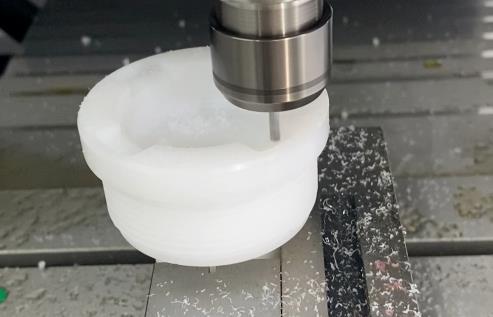Ceramic materials play an indispensable role in cutting-edge industries such as aerospace, semiconductors, medical devices, optical components, and industrial equipment due to their exceptional hardness, wear resistance, high-temperature stability, electrical insulation, and chemical inertness. However, these remarkable properties also make ceramics extremely challenging to machine. Ceramic CNC machining technology has emerged as the key process for producing high-precision, complex-shaped ceramic parts. This guide will delve into the core technologies, applications, and solutions to common issues in ceramic CNC machining.
1. What is Ceramic CNC Machining?
Ceramic CNC machining is a process that uses computer numerical control (CNC) machines to precisely remove material from ceramic blanks or pre-sintered components based on pre-programmed instructions. This results in parts with specific geometries, dimensional accuracy, and surface quality. Compared to traditional kiln-fired or manual processes, CNC machining offers unparalleled precision, repeatability, and the ability to process complex shapes, making it especially suitable for small batches, high-precision, or prototype manufacturing.
2. Key Characteristics of Ceramics in CNC Machining
Understanding the intrinsic characteristics of ceramics is crucial to successful machining:
- High Hardness and Wear Resistance: Ceramics exceed most metals in hardness, leading to significant tool wear (diamond tools are required).
- Brittleness: Lacking ductility, ceramics tend to crack or fracture under mechanical stress rather than deform. This makes the process highly sensitive to machining parameters (cutting force, vibration).
- Low Thermal Conductivity: The heat generated during machining is not easily dissipated, which can lead to thermal cracking or exacerbate tool wear. Cooling is essential.
- Low Tensile Strength: Ceramics are sensitive to tensile stress, and design should avoid sharp corners, thin walls, and cantilevered structures.
- High Chemical Stability: Ceramics are corrosion-resistant, but certain types require specific coolant compositions.
- Anisotropy: Some ceramics (e.g., graphite) have directional properties, affecting machining strategies.
3. How Does Ceramic CNC Machining Work?
Ceramic CNC machining is a highly systematized process:
- CAD Design: Create a 3D digital model of the part using computer-aided design (CAD) software.
- CAM Programming: Import the CAD model into computer-aided manufacturing (CAM) software to generate the tool paths (G-code) for controlling machine movements. This stage requires precise cutting parameters (speed, feed rate, depth of cut), tool selection, and cooling strategies.
- Machine Setup: Install suitable diamond or cubic boron nitride (CBN) tools on the CNC machine, secure the ceramic workpiece (carefully to avoid cracking), and set up the cooling system (usually oil mist or minimal quantity lubrication).
- Machining Execution: The CNC system reads the G-code to precisely control the tool's movement along the designated paths, using milling, turning, drilling, grinding, etc., to remove material.
- Post-Processing: After machining, parts may require cleaning, deburring (special techniques required), polishing, or heat treatment (for some pre-sintered components).
4. Key CNC Machines and Tools for Ceramic Machining
Primary machine types include CNC Milling/Machining Centers, CNC Lathes/Turning Centers, and CNC Grinders. The tools primarily used include:
- Diamond Tools: The absolute mainstream, including Polycrystalline Diamond (PCD) Tools, Single Crystal Diamond Tools, and Diamond Grinding Wheels.
- Cubic Boron Nitride (CBN) Tools: Second only to diamond in hardness, better heat resistance, suitable for certain high-temperature alloys or specific ceramics.
5. Types of Ceramics Used in CNC Machining
Not all ceramics are easy to machine. Commonly used engineering ceramics suitable for CNC machining include:
- Alumina (Al2O3): The most widely used, with high hardness, good insulation, and relatively low cost.
- Boron Nitride (BN): Self-lubricating, easy to machine (often called “white graphite”), high insulation, high-temperature resistant.
- Zirconia (ZrO2): Offers the highest strength and toughness among ceramics, biocompatible (for medical applications), wear-resistant.
- Silicon Carbide (SiC): Extremely hard, high thermal conductivity, and wear-resistant. Very difficult to machine, typically requiring grinding or special processes.
6. Applications of Ceramic CNC Machining
Ceramic CNC components are widely used in industries that demand high performance:
- Semiconductor Manufacturing: Wafer fixtures, insulators, process chamber components, plasma spray nozzles.
- Medical Devices: Artificial joints, dental implants/restorations, surgical instrument parts.
- Aerospace: Rocket nozzles, thermal protection tiles, sensor housings, aerospace engine parts.
7. Troubleshooting Common Issues in Ceramic CNC Machining
Common problems include edge chipping, poor surface finish, excessive tool wear, and more. Solutions involve:
- Edge Chipping/Fracturing: Reduce feed rate, minimize cutting depth, use sharp diamond tools, improve workpiece support.
- Poor Surface Finish: Replace dull tools, optimize cutting parameters, enhance rigidity, ensure effective cooling.
- Excessive Tool Wear: Optimize cutting parameters, enhance cooling, select more wear-resistant tools.
8. Future Trends in Ceramic CNC Machining
Expect advancements in high-speed/ultra-precision machining, new tool technologies, hybrid machining, process monitoring, and additive manufacturing integration.
Need Professional Ceramic CNC Machining Services? Get in touch with us today for high-precision solutions.



